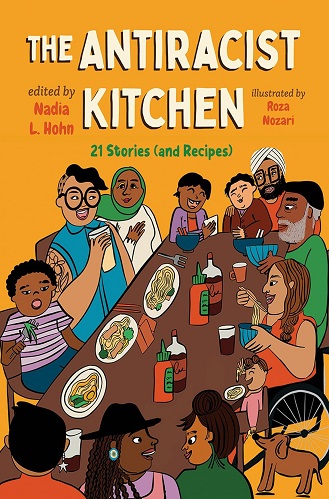What if talking about racism was as easy as baking a cake, frying plantains or cooking rice? The Antiracist Kitchen: 21 Stories (and Recipes) is a celebration of food, family, activism and resistance in the face of racism. In this anthology featuring stories and recipes from 21 diverse and award-winning North American children’s authors, the authors share the role of food in their lives and how it has helped fight discrimination, reclaim culture and celebrate people with different backgrounds. They bring personal and sometimes difficult experiences growing up as racialized people.
I opened the cover of this book with a big helping of skepticism. How does a book combine recipes – and stories on racism? What middle-grader is interested in a book on either topic, let alone the awkward combination? Is a middle-grader really going to seize the book and carry it into the kitchen to try cooking fried bologna and ketchup pizza? Are their parents going to let them? And except for readers who find their own ethnicity represented in one of the stories (which range from Cherokee to Mexican, Nigerian to Korean), will anyone else (the kids who most need it) relate? Since when does a book purporting to be for middle-grade readers have a 56-word glossary with gobsmackers like “allyship,” “cultural genocide,” “white supremacy,” “mass incarceration” and “food desert” – never mind “offal” and “pemmican?” Finally, how naturally does a book on food break into sections labelled “Reclaim, Resist, Restore, Rejoice?”
Being a collection of stories by 21 different authors (six of them male), naturally the quality of the stories varies. Some are poignant, some are stirring, some are on the weak side. The best ones reach out and touch a reader of any color or experience; they offer teachable moments and memorable anecdotes.
I’m planting some small black Cherokee Trail of Tears beans in my garden. This bean is so named because Cherokees carried it with them when they were illegally forced to leave their ancestral homelands and walk more than a thousand miles to Indian Territory.
“There are no such things as green bananas. They are supposed to be yellow,” said Mrs. D.
I stood beside her feeling embarrassed and said nothing, too scared to tell her that she was wrong, that my family bought green bananas every Saturday at the Caribbean food market. That we ate boiled green bananas with yam, coco and dumplings.
Some of the grownups are not ready for you. Because they stop talking and just stare. And suddenly you remember that you are the only Black kid on the property.
Your friend takes you to the table for a plate, but there are green olives on the deviled eggs. And, even worse, your friend’s mom’s best friend runs over to say, “I heard you were coming, so I brought you some fried chicken, and there’s also some watermelon and…”
And now everyone is staring at you, and you’ve never been so not hungry in your entire life.
Instead of eating lunch with everyone, I ate in the bathroom where no one could see me. Every day, I begged Mom to make me a cheese sandwich so I could fit in with everyone… Then all the kids at school could shut up about my lunch. Except part of me knew that no matter what I had in my lunch bag, I’d still be the target. That’s what came with being the only Chinese kid at school.
Suffice it to say the book’s premise is a noble idea, most of the stories are well worth reading (perhaps aloud in class?), the recipes may inspire the occasional kid to cook, and – just maybe – the heavy-handed material on “racism, tolerance, allyship, empathy, restoration, stereotypes…” might enlighten some.
-Pam Withers


